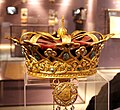This article cites Wikipedia (or sources that take information from Wikipedia) in a circular manner .(June 2024) |
The Regalia of Romania are a set of items which were used for the coronation of the kings and queens of Romania. They are kept in the National Museum of Romanian History in Bucharest and consist of the Royal Crown (the Steel Crown of Romania), the Crown of Queen Elizabeth, the Crown of Queen Maria, orbs, the Scepter of King Ferdinand I, the Scepter of King Carol II, the Sword of King Carol I and the Royal Mantle. [1]







